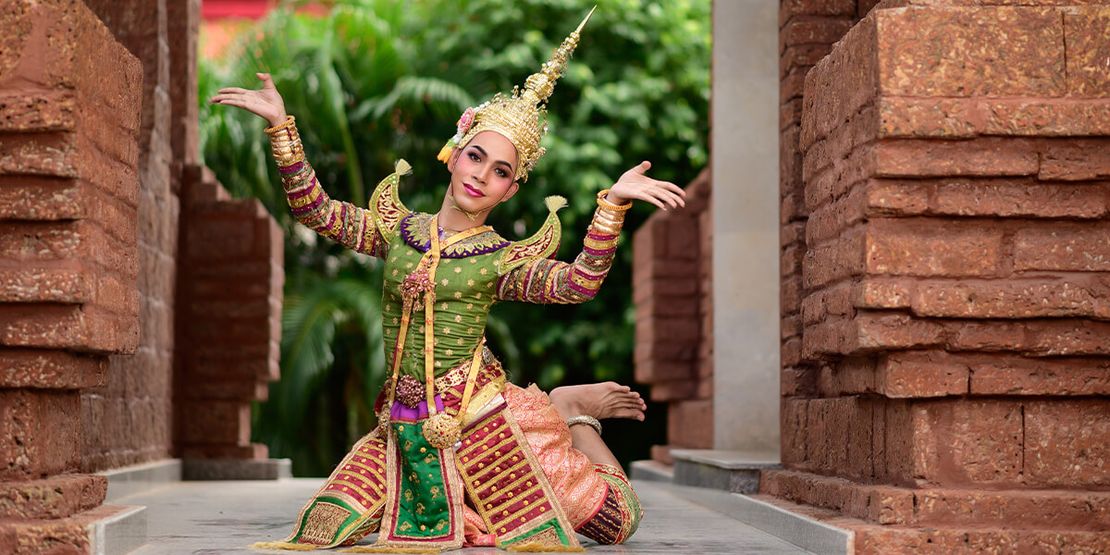Thai National Theatre: A Cultural Showcase in Bangkok
A planned trip to Thailand, where you seek relaxation, is not perfect without visiting the Thai National Theatre in Krung Thep Maha Nakhon (Bangkok). Performing arts, regardless of the specific field, have a unique ability to both relax and stimulate the minds of people in a city. For many, appreciating art is an integral part of their cultural identity. It is a reflection of the nation's rich heritage and traditions.
Having a national theater serves as a central hub for the performing arts and provides a platform for showcasing talent is of utmost importance. Therefore, acquainting yourself with the Thai National Theater in Bangkok is a significant cultural experience.
Thai culture is renowned for its traditional dances, and visiting a Khon performance at Bangkok's National Theatre is a valuable and authentic cultural experience. Join us now as we explore this cultural gem!
The Thai theater style is known as Kohn and consists of dance and drama acts in which the actors wear masks and act out stories from the Ramakien.
Immerse Yourself in Bangkok's Traditional Cultural Performances
When traveling in Thailand and seeking a delightful way to spend your evening after a day of exploration, attending a traditional night show is an excellent choice. Many major tourist destinations in Thailand offer high-quality performances featuring skilled entertainers, captivating costumes, and a vibrant atmosphere.
Thailand boasts two traditional theater forms: Khon and Lakhon. Khon, dating back to the 15th century, was primarily designed for the royal court's entertainment. Lakhon, on the other hand, was initially performed exclusively within the palace and is characterized by somewhat slower and more graceful movements.
Both forms are accompanied by a Piphat, which is a small orchestra that uses traditional Thai instruments. Attending one of these shows is a fantastic and captivating experience that will definitely leave you amazed.
Thai theater began in the Middle Ages and is based on Hindu epic tales. The primary forms are Khon and Lakhon, with dancers, songs, and orchestral accessories.
Unveiling the History of the Thai National Theatre
The history of Thai theater can be traced back to the Middle Ages when it found its roots in classical Hindu tales. Thai dance dramas are known for their complexity, featuring vibrant costumes and intricate choreography that takes years of dedication to master. Thailand boasts a rich theatrical culture, encompassing dance dramas, indigenous music, and modern theater.
As mentioned previously, two prominent forms of traditional theater in Thailand are Khon and Lakhon. In both styles, the actors are mimes, while singers and choirs provide the lyrical component. These performances are typically accompanied by a traditional orchestra known as Piphat, which plays a vital role in conveying emotions and setting the atmosphere.
Khon Performance: Thailand's Premier Theatrical Tradition
Khon is Thailand's most celebrated theatrical form, dating back to the 16th century. The name "Khon" is believed to have been inspired by a drum-like instrument crafted from Indian leather, traditionally used in royal ceremonies.
Khon performances involve a troupe of dancers and were historically staged to entertain the royal court. In contemporary presentations, Khon showcases condensed versions of various episodes from the Ramakien, a narrative rooted in the Ramayana, one of Hinduism's most significant epics. Travelers can savor these vibrant performances during their meals, providing a medley of visual and culinary delights.
A Khon production features various characters, the most prominent being Hanuman and Phra Ram, two heroic monkey warriors. These characters are notable for wearing masks, a characteristic of Khon. While traditionally, all roles were exclusively portrayed by men, today, it is common for women to join the cast. Each Khon show revolves around a cast of characters that typically includes a hero, heroine, ogre, and monkey as the central figures.
Lakhon Performance: A Glimpse into Traditional Thai Dance Drama
Lakhon, the mesmerizing Thai dance-drama, encompasses two distinctive styles: Lakhon Nai and Lakhon Chatri. Lakhon Nai, or "theater for the women of the palace," has a tranquil history, with early performances exclusively held within palace walls and executed by women. On the other hand, Lakhon Chatri takes its roots from Central Thailand and narrates stories of royalty. Performers in Lakhon Chatri deliver their lines while accompanied by a live musical ensemble.
Lakhon Chatri's prominence began to soar during the 18th century. In 1832, a military general suppressed a rebellion in the South and brought numerous Lakhon Chatri performers with him. The group's creations gained acclaim, and subsequent generations have diligently preserved this rich tradition. Lakhon Chatri typically unfolds on a square stage with four corner poles, where the central pole, Sao Mahachai, takes center stage. The main character is recognized by their elaborate costume, distinguishing them from the ensemble.
Before each performance, a ceremony pays tribute to the teachers, followed by an orchestral invitation. The main character commences with a sat dance and intones an incantation, seeking protection from evil entities. As the main character sings, other performers harmonize in chorus. To conclude, the protagonist performs a sat dance while chanting the initial enchantment in reverse, symbolizing its reversal and release.
The Ramakien: Thailand's National Folk Tale
The Ramakien holds a special place in Thai folklore and is an adaptation of the Hindu epic, the Ramayana. This captivating tale has evolved into three distinct versions over time. Thai people first embraced the story in the early first millennium, with the earliest records tracing back to the Sukhothai kingdom, where it was conveyed through shadow-puppet performances.
The earliest written version of the Ramakien emerged in the 18th century, and the rendition performed today was carefully prepared and refined by Rama I and his successors. Rama II made his own alterations to his father's version, primarily intended for Khon theater. This rendition emphasized Hanuman, the god-king of the apes, and introduced a happier ending to the story.
While the core plot remains faithful to the Ramayana, the Ramakien has been adapted to the Thai context, incorporating changes in attire, weaponry, settings, and more. Beyond its enthralling narrative, the epic also weaves a creation myth for Thailand and stands as an integral element of Thai cultural heritage.
Why Visit the Thai National Theatre in Bangkok?
For theater enthusiasts, the National Theater of Thailand is a must-visit destination. It hosts Khon and Lakhon classical performances in the Thai language. While not understanding the language might be a limitation in grasping the plot, the opulent setting and intricate traditional costumes of the cast more than make up for it. If you're not in the mood for a theater performance, you might find yourself at a live concert, as the National Theater also features a live music venue.
The National Theater is an excellent choice for travelers interested in exploring the arts and the Thai cultural scene. The Khon show offered here is quite affordable, with ticket prices ranging between 100 to 200 THB. It's a fantastic place to immerse yourself in Thai art and culture. The show is relatively long, lasting about 2.5 hours, so arrive before the performance begins. The production is quite grand, featuring elaborate costumes and live Thai music.
Thailand's National Theatre is known for showcasing Thai Classical drama, with performances of Khon, a traditional drama in which actors wear traditional Thai masks. These productions are awe-inspiring, featuring incredibly ornate costumes and exceptional lighting. You can also witness elegant Thai dance and music performances on the last Friday and Saturday of each month.
How to Visit the Thai National Theatre in Bangkok?
The National Theatre is conveniently located on Na Phra That Road, near Thammasat University and the National Museum. If traveling by Express Boat, you can disembark at Banglamphu Pier, walk along the river toward Pinklao Bridge, pass under the bridge, and continue towards Sanam Luang. Take a right turn, and you'll find the National Theatre on your right.
You can also reach the National Theatre by taking the following buses:
- Non Air-conditioned Bus Number: 3, 9, 59, 64, 65, 70, 201
- Air-conditioned Bus Number: 39, 59, 82
The most famous theatre in Bangkok is probably the Thai National Theatre.
Maps & More Information
The National Theatre Bangkok is a performing arts place in Phra Nakhon District. It was established in 1965 and is a government organization that works under the Office of Performing Arts of the Fine Arts Department. Today, it is best recognized for traditional achievements, especially the Khon masked dance.
|
Entrance Fees |
Starting 100 THB |
|
Business Address |
No. 2, Ratchawithi Road, Phra Borom Maha Ratchawang Subdistrict, Phra Nakhon District, Bangkok 10200 |
|
Operational Hours |
09:00 - 16:00 | Monday to Sunday |
|
Phone Number |
+66 (0) 22-241-342 | +66 (0) 22-210-171 |
|
Email Address |
|
|
Website |
|
|
|
|
|
YouTube |
|
|
GPS |
13.7590935, 100.4925301 |
The Bear Team
We, The Bear Team, are a united group of digital experts and adventurers. Combining technical skills with creative flair, we deliver informative, valuable, up-to-date content. Whether seeking travel inspiration or innovative solutions, we're your go-to for fun, authentic, impactful, and timeless experiences.
The Bear Travel | Experience like a Local
A fast-growing Thailand Travel Blog written by Expats and Thais since 2017. We will share our experiences and ideas from an insider point of view for you to create your own unique Thailand experience.
For the latest news and events about The Bear Travel, follow us on Facebook, Instagram, Twitter, Pinterest, or YouTube.
For any issues, concerns, or queries, don’t hesitate to CONTACT us.
Recommended for you
Sanctuary Cafe & Restaurant: Excellent Food at Pak Nam
Tle (Hungry Bear)
Top 10 Reasons Why We Should Enjoy a Krabi Holiday
Marc Tubelleja (Curious Bear)
Firehouse: A Pleasant Pub and Restaurant in Bangkok
Tle (Hungry Bear)
Travel to Phuket: A Hopping Day Trip Itinerary to its Stunning Islands
Sydney, The Bear Traveler (The Bear Travel)
Top 10 Best Islands in Thailand for Snorkeling and Diving
Rowan (Guinness Bear)
























